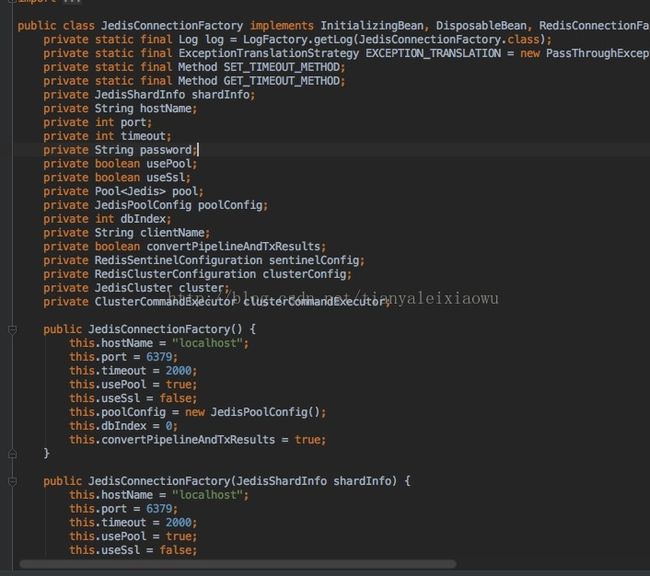spring boot对常用的数据库支持外,对nosql 数据库也进行了封装自动化。
redis介绍
Redis是目前业界使用最广泛的内存数据存储。相比memcached,Redis支持更丰富的数据结构,例如hashes, lists, sets等,同时支持数据持久化。除此之外,Redis还提供一些类数据库的特性,比如事务,HA,主从库。可以说Redis兼具了缓存系统和数据库的一些特性,因此有着丰富的应用场景。本文介绍Redis在Spring Boot中两个典型的应用场景。
如何使用
1、引入 spring-boot-starter-redis
org.springframework.boot
spring-boot-starter-redis
2、添加配置文件
# REDIS (RedisProperties)
# Redis数据库索引(默认为0)
spring.redis.database=0
# Redis服务器地址
spring.redis.host=192.168.0.58
# Redis服务器连接端口
spring.redis.port=6379
# Redis服务器连接密码(默认为空)
spring.redis.password=
# 连接池最大连接数(使用负值表示没有限制)
spring.redis.pool.max-active=8
# 连接池最大阻塞等待时间(使用负值表示没有限制)
spring.redis.pool.max-wait=-1
# 连接池中的最大空闲连接
spring.redis.pool.max-idle=8
# 连接池中的最小空闲连接
spring.redis.pool.min-idle=0
# 连接超时时间(毫秒)
spring.redis.timeout=0
3、添加cache的配置类
@Configuration
@EnableCaching
public class RedisConfig extends CachingConfigurerSupport{
@Bean
public KeyGenerator keyGenerator() {
return new KeyGenerator() {
@Override
public Object generate(Object target, Method method, Object... params) {
StringBuilder sb = new StringBuilder();
sb.append(target.getClass().getName());
sb.append(method.getName());
for (Object obj : params) {
sb.append(obj.toString());
}
return sb.toString();
}
};
}
@SuppressWarnings("rawtypes")
@Bean
public CacheManager cacheManager(RedisTemplate redisTemplate) {
RedisCacheManager rcm = new RedisCacheManager(redisTemplate);
//设置缓存过期时间
// rcm.setDefaultExpiration(10);//秒
return rcm;
}
@SuppressWarnings({ "rawtypes", "unchecked" })
@Bean
public RedisTemplate redisTemplate(RedisConnectionFactory factory) {
StringRedisTemplate template = new StringRedisTemplate(factory);
Jackson2JsonRedisSerializer jackson2JsonRedisSerializer = new Jackson2JsonRedisSerializer(Object.class);
ObjectMapper om = new ObjectMapper();
om.setVisibility(PropertyAccessor.ALL, JsonAutoDetect.Visibility.ANY);
om.enableDefaultTyping(ObjectMapper.DefaultTyping.NON_FINAL);
jackson2JsonRedisSerializer.setObjectMapper(om);
template.setValueSerializer(jackson2JsonRedisSerializer);
template.afterPropertiesSet();
return template;
}
}
好了,接下来就可以直接使用了
@RunWith(SpringJUnit4ClassRunner.class)
@SpringApplicationConfiguration(Application.class)
public class TestRedis {
@Autowired
private StringRedisTemplate stringRedisTemplate;
@Autowired
private RedisTemplate redisTemplate;
@Test
public void test() throws Exception {
stringRedisTemplate.opsForValue().set("aaa", "111");
Assert.assertEquals("111", stringRedisTemplate.opsForValue().get("aaa"));
}
@Test
public void testObj() throws Exception {
User user=new User("[email protected]", "aa", "aa123456", "aa","123");
ValueOperations operations=redisTemplate.opsForValue();
operations.set("com.neox", user);
operations.set("com.neo.f", user,1,TimeUnit.SECONDS);
Thread.sleep(1000);
//redisTemplate.delete("com.neo.f");
boolean exists=redisTemplate.hasKey("com.neo.f");
if(exists){
System.out.println("exists is true");
}else{
System.out.println("exists is false");
}
// Assert.assertEquals("aa", operations.get("com.neo.f").getUserName());
}
}
以上都是手动使用的方式,如何在查找数据库的时候自动使用缓存呢,看下面;
4、创建个JavaBean对象。
@Entity
public class Post implements Serializable{
@Id
@GeneratedValue(strategy = GenerationType.AUTO)
private Integer id;
private String content;
private Integer weight;
public Integer getId() {
return id;
}
public void setId(Integer id) {
this.id = id;
}
public String getContent() {
return content;
}
public void setContent(String content) {
this.content = content;
}
public Integer getWeight() {
return weight;
}
public void setWeight(Integer weight) {
this.weight = weight;
}
}
5、创建个repository
@CacheConfig(cacheNames = "post")
public interface PostRepository extends PagingAndSortingRepository {
@Cacheable(key = "#p0")
Post findById(int id);
/**
* 新增或修改时
*/
@CachePut(key = "#p0.id")
@Override
Post save(Post post);
@Transactional
@Modifying
@CacheEvict(key = "#p0")
int deleteById(int id);
}
这个里面有个CacheConfig,配置了cacheNames。
- 我在findById方法时加了个@Cacheable(key= "#p0"),#p0代表第一个参数,也就是id。这句话加上之后,当你在调用findById时,就会先从redis的post缓存对象里去查询key等于传过来的id的值。如果没有,就去查表。
- 在save方法上加了个CachePut,代表往缓存里添加值,key为参数post的id属性,这样当我们save一个Post对象时,redis就会新增一个以id为key的Post对象;如果是update操作,那同样,redis会覆盖id相同的Post对象的值,也完成一次更新。
- 在delete方法上加了个@CacheEvict(key = "#p0"),当调用deleteById时,就会同时清空指定key的缓存。
- 更多标签,请看cache标签用法
这样,在对post的增、删、改、查时都会自动缓存到redis里。下面来验证一下。
加个service
@Service
public class PostService {
@Autowired
private PostRepository postRepository;
public Post findById(int id) {
return postRepository.findById(id);
}
public Post save(Post post) {
return postRepository.save(post);
}
public int delete(int id) {
return postRepository.deleteById(id);
}
}
来个controller
@RestController
public class PostController {
@Autowired
private PostService postService;
@RequestMapping("/query/{id}")
public Object query(@PathVariable int id) {
return postService.findById(id);
}
@RequestMapping("/save")
public Object save(@ModelAttribute Post post) {
return postService.save(post);
}
@RequestMapping("/delete/{id}")
public Object delete(@PathVariable int id) {
return postService.delete(id);
}
@RequestMapping("/queryPage")
public Object query(String name, int pageNum, int count) {
//根据weight倒序分页查询
// Pageable pageable = new PageRequest(pageNum, count, Sort.Direction.DESC, "weight");
// return userRepository.findByName(name, pageable);
return null;
}
}
然后启动Application,在启动之前需要加上@EnableCaching注解,缓存才能正常工作。
@SpringBootApplication
@EnableCaching
public class Demo0Application {
public static void main(String[] args) {
SpringApplication.run(Demo0Application.class, args);
}
}
启动后访问 http://localhost:8080/save?content=1&weight=1
如果想看是否能够正常缓存,有三种方法:
- 在加缓存控制的地方打系统日志,比如
/**
* 新增或修改时
*/
@CachePut(key = "#p0.id")
@Override
Post save(Post post){
system.out.println("命中缓存时将不会打印此日志");
}
}
- 在applcation.properties中设置sql控制台日志打开
show-sql: true
- 登陆redis服务器查看响应的key值是否有增、删、改的变化。
# 获取所有keys
keys *
# 查看目标key是否有效
get
# 查询操作时,使用的是get方法;新增和更新时,用的set方法;删除时,用的del方法,可以分别查看响应操作时,对应的key是否发生了正确的变化
然后访问查询,http://localhost:8080/query/1
会发现查询到了id为1的这条记录,并且控制台没有走select查询语句,也就是根本没访问数据库,直接从redis缓存拿的值。
下面做一个更新操作,看看是否会同步到redis里。http://localhost:8080/save?content=1&weight=2&id=1
把weight改为2,访问地址看看结果。
控制台打印了两条语句
hibernate: select post0_.id as id1_0_0_, post0_.content as content2_0_0_, post0_.weight as weight3_0_0_ from post post0_ where post0_.id=?Hibernate: update post set content=?, weight=? where id=?
说明数据已经被更新了。然后再查询http://localhost:8080/query/1
发现查到的数据已经改变,并且控制台没有走select语句,说明在update时,redis已经更新了。
下面做删除操作,可以直接在数据库里删这条记录,或者通过浏览器访问来删除。http://localhost:8080/delete/1
控制台走了删除delete语句,redis也一并删除了,这时执行查询将会看不到响应的数据。
这样我们就完成了一个最简单的整合redis的demo。包括了对单个对象的增删改查的缓存。
那么下面来讲几个疑问:
-
为什么不用配置redis的地址,port,密码什么的?
上面的那些默认的对redis的操作,来源于Springboot里整合的RedisTemplate,template里会默认使用一个JedisConnectionFactory来做默认的连接属性配置。
这里面已经对jedis的连接地址和jedisPool做了初始化操作了,都是默认值。系统就会使用这些默认值来操作redis。后面我们会对Connection进行自定义,设置value的序列化方式,还有修改连接地址,那时就会使用自定义的配置了。
能否用上面的方法来存储集合?譬如所有的Post集合,当新增时集合也随之改变?
不行的,假如给ListfindAll做了个缓存,那下次查询时确实不用查表了,但是当你新增、修改、删除任何一个对象时,这个缓存的集合都是不变的。
除非你在所有的能修改对象的地方,都加上CacheEvict,key为集合的key,这样任何修改,都是删除整个集合对象的缓存,下次再查时才能缓存起来。而大部分时候,集合对象都是在不停变化的,除了一些不变的如城市列表之类的,其他的都不适合用这种缓存方式。会导致频繁创建大对象,而且大部分时候也不需要查整个集合,而是分页。怎么用redis来做集合查询,分页查询,甚至于条件分页查询
参考文档
http://blog.csdn.net/tianyaleixiaowu/article/details/70314277
https://yq.aliyun.com/articles/91595?t=t1
http://blog.csdn.net/tianyaleixiaowu/article/details/70595073

